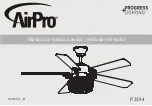
EACH WIRE NUT (WIRE CONNECTOR) SUPPLIED
WITH THIS FAN IS DESIGNED TO ACCEPT UP TO
ONE 12 GAUGE HOUSE WIRE AND TWO WIRES
FROM THIS FAN. IF YOU HAVE LARGER THAN
12 GAUGE HOUSE WIRING OR MORE THAN
ONE HOUSE WIRE TO CONNECT TO THE FAN
WIRING, CONSULT AN ELECTRICIAN FOR THE
PROPER SIZE WIRE NUTS TO USE.
USE THE PLASTIC WIRE CONNECTORS
SUPPLIED WITH YOUR FAN. SECURE THE
CONNECTORS WITH ELECTRICAL TAPE AND
ENSURE THERE ARE NO LOOSE STRANDS OR
CONNECTIONS.
B
LUE
B
LA
CK
W
HIT
E
G
RE
EN
BLUE
BLACK
WHITE
WHITE
SUPPLY CIRCUIT
B
LA
CK
W
HIT
E
Grounding
Conductor
Green
Grounding
Lead
Remote
Receiver
Figure 11
Making the Electrical
Connections
REMEMBER to disconnect the power. If
you feel you do not have enough electrical
wiring knowledge or experience, have your fan
installed by a licensed electrician.
Follow the steps below to connect the fan to
your household wiring. Use the wire
connecting nuts supplied with your fan and
supplied with remote control. Secure the
connectors with electrical tape. Make sure
there are no loose strands or
connections. (Figure 11)
1.
Connect the ground conductor of the 120v
supply (this may be a bare wire or a wire
with green colored insulation) to the green
ground lead(s) of the fan (Figure 11).
2. Connect the fan motor white wire to the
receiver white wire using a wire nut (Figure
11).
3. Connect the fan motor black wire to the
receiver black wire using a wire nut (Figure
11).
4. Connect the fan motor blue wire to the
receiver blue wire using a wire nut (Figure
11).
7.
5. Connect the receiver black wire to the
supply black (hot) wire using a wire nut
(Figure 11).
6. Connect the receiver white wire to the
supply white (neutral) wire using a wire nut
(Figure 11).
7. After connecting the wires, spread them
apart so that the green and white wires are
one side of the electrical box and the black
wire is on the other side.
8. Turn the wire connecting nuts upward and
carefully push the wiring into the electrical
box.











































